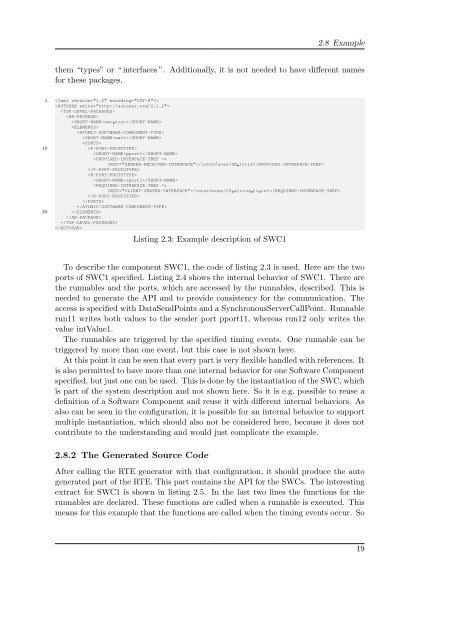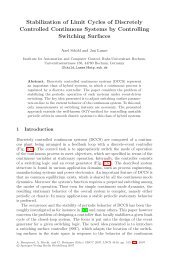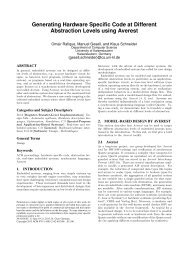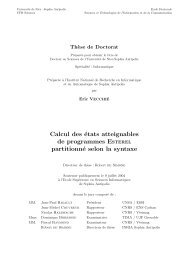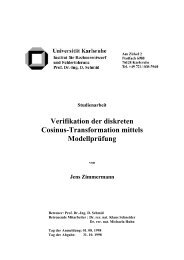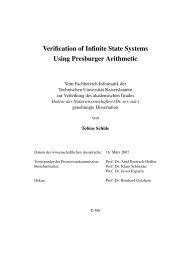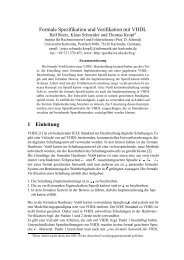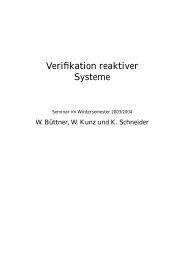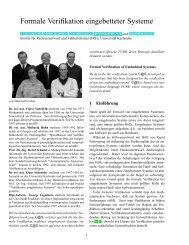Evaluation Environment for AUTOSAR-Autocode in Motor Control ...
Evaluation Environment for AUTOSAR-Autocode in Motor Control ...
Evaluation Environment for AUTOSAR-Autocode in Motor Control ...
Create successful ePaper yourself
Turn your PDF publications into a flip-book with our unique Google optimized e-Paper software.
2.8 Example<br />
them “types” or “ <strong>in</strong>terfaces ”. Additionally, it is not needed to have different names<br />
<strong>for</strong> these packages.<br />
1 <br />
<br />
<br />
<br />
swc root<br />
<br />
<br />
swc1<br />
<br />
10 <br />
pport1<br />
/<strong>in</strong>terfaces/SR Int16<br />
<br />
<br />
rport1<br />
/<strong>in</strong>terfaces/CS str<strong>in</strong>g to <strong>in</strong>t<br />
<br />
<br />
<br />
20 <br />
<br />
<br />
<br />
List<strong>in</strong>g 2.3: Example description of SWC1<br />
To describe the component SWC1, the code of list<strong>in</strong>g 2.3 is used. Here are the two<br />
ports of SWC1 specified. List<strong>in</strong>g 2.4 shows the <strong>in</strong>ternal behavior of SWC1. There are<br />
the runnables and the ports, which are accessed by the runnables, described. This is<br />
needed to generate the API and to provide consistency <strong>for</strong> the communication. The<br />
access is specified with DataSendPo<strong>in</strong>ts and a SynchronousServerCallPo<strong>in</strong>t. Runnable<br />
run11 writes both values to the sender port pport11, whereas run12 only writes the<br />
value <strong>in</strong>tValue1.<br />
The runnables are triggered by the specified tim<strong>in</strong>g events. One runnable can be<br />
triggered by more than one event, but this case is not shown here.<br />
At this po<strong>in</strong>t it can be seen that every part is very flexible handled with references. It<br />
is also permitted to have more than one <strong>in</strong>ternal behavior <strong>for</strong> one Software Component<br />
specified, but just one can be used. This is done by the <strong>in</strong>stantiation of the SWC, which<br />
is part of the system description and not shown here. So it is e.g. possible to reuse a<br />
def<strong>in</strong>ition of a Software Component and reuse it with different <strong>in</strong>ternal behaviors. As<br />
also can be seen <strong>in</strong> the configuration, it is possible <strong>for</strong> an <strong>in</strong>ternal behavior to support<br />
multiple <strong>in</strong>stantiation, which should also not be considered here, because it does not<br />
contribute to the understand<strong>in</strong>g and would just complicate the example.<br />
2.8.2 The Generated Source Code<br />
After call<strong>in</strong>g the RTE generator with that configuration, it should produce the auto<br />
generated part of the RTE. This part conta<strong>in</strong>s the API <strong>for</strong> the SWCs. The <strong>in</strong>terest<strong>in</strong>g<br />
extract <strong>for</strong> SWC1 is shown <strong>in</strong> list<strong>in</strong>g 2.5. In the last two l<strong>in</strong>es the functions <strong>for</strong> the<br />
runnables are declared. These functions are called when a runnable is executed. This<br />
means <strong>for</strong> this example that the functions are called when the tim<strong>in</strong>g events occur. So<br />
19


